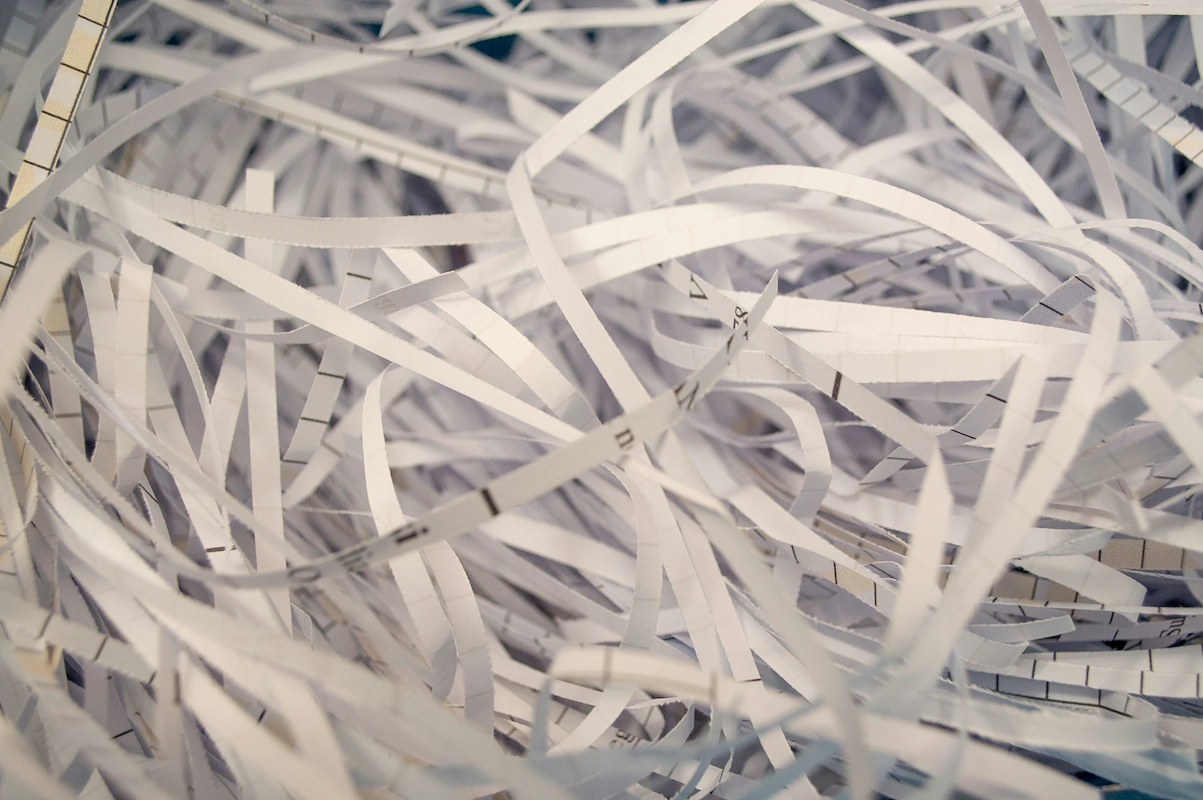Starting a paper shredding business is a rewarding venture that combines logistical planning and a commitment to security with sharp business savvy. The market for secure document destruction is worth billions, driven by steady demand from sectors like healthcare, finance, and legal services that handle sensitive information.
This guide will take you through the practical steps of validating your business idea, acquiring the right equipment, obtaining necessary licenses, and securing funding to help you launch a successful paper shredding business in the U.S.
Step 1: Validate your market and plan your budget
Your first move is to understand local demand. Contact potential clients like law firms, medical offices, and financial advisors. Ask if they currently use a shredding service, their satisfaction level, and what they pay. This direct feedback is invaluable.
For broader industry insights, review publications from the National Association for Information Destruction (NAID). Their reports offer data on market trends and compliance standards that will shape your service offerings.
Analyze your local competition
Next, map out your competition. Use Google Maps and local business directories to find every shredding service nearby. A frequent oversight is to focus only on national brands, but small local operators are often your most direct competitors.
Estimate your startup costs
With a clearer picture of the market, you can build a realistic budget. The shredding truck represents the largest part of your initial investment, so it is wise to explore both new and used options to manage this expense.
- Shredding Truck: $50,000 - $150,000+ (used vs. new)
- Insurance (first year): $5,000 - $10,000 for general and professional liability.
- Licenses & Certification: $1,000 - $3,000 for business registration and initial NAID certification fees.
- Initial Marketing: $2,000 - $5,000 for a website and local ads.
This brings your estimated initial investment to between $58,000 and $168,000. This range helps you prepare for financing discussions and shows what it takes to start with professional-grade equipment.
Here are three immediate steps to take:
- Contact at least 10 local businesses to inquire about their document destruction needs.
- Create a list of all shredding services within a 50-mile radius using online maps and directories.
- Draft a startup budget using the cost estimates provided to understand your funding needs.
Step 2: Establish your legal structure and get licensed
Choose your business structure
You should consider forming a Limited Liability Company (LLC). It protects your personal assets from business debts and allows profits to pass directly to your personal tax return, which avoids corporate double taxation.
A C Corporation is another option, but it involves more complex tax filings. For most new shredding businesses, an LLC provides the right balance of protection and simplicity. Registration costs with your Secretary of State typically range from $50 to $500.
Secure the right permits and certifications
First, get a free Employer Identification Number (EIN) from the IRS website. You will need this to open a business bank account and hire employees. Next, check with your city and county clerk for a general business operating license.
The most important credential in this industry is the NAID AAA Certification from the International Secure Information Governance & Management Association (i-SIGMA). While not a government license, clients demand it. The initial audit costs about $1,500.
A frequent misstep is to delay preparation for the NAID audit. It is a detailed process that examines your security policies, employee screening, and destruction procedures. Download their requirements early to build your operations correctly from day one.
Here are 4 immediate steps to take:
- Decide on your business structure and visit your Secretary of State's website to review the LLC filing process.
- Apply for a free Employer Identification Number (EIN) directly from the IRS.
- Contact your local city hall to ask about the application for a general business license.
- Download the NAID AAA Certification specifications to understand security requirements.
Step 3: Secure your insurance and manage risk
Understand your coverage needs
With your legal structure in place, the next step is to protect your business. You will need several types of insurance. Many new owners make the mistake of getting a generic policy, but shredding has unique risks, like data breaches, that demand specific coverage.
Here is a breakdown of the policies you should discuss with an agent:
- General Liability: Covers property damage or injury. Plan for $1 million in coverage, with annual premiums of $500 to $1,200.
- Professional Liability (E&O): Protects you if a client claims financial loss due to an error. This is vital for data breach claims. A $1 million policy can cost $1,000 to $2,500 annually.
- Commercial Auto: Covers your shredding truck. Expect to pay $1,500 to $4,000 per vehicle each year.
- Workers’ Compensation: Required if you have employees. Costs vary by state and payroll size.
Find the right insurance provider
You might want to work with an agent who understands information destruction. General agents may not grasp the specific risks involved. Consider providers like Insureon, The Hartford, or Chubb, as they have experience with specialized commercial operations and can find appropriate policies.
When you get quotes, confirm that the professional liability policy explicitly covers data breach incidents. This detail can save your business from a catastrophic claim. Always review the policy documents yourself before you commit to payment.
Here are 4 immediate steps to take:
- Contact at least three insurance providers that specialize in commercial business coverage for quotes.
- Ask each provider to detail their professional liability coverage for data breach incidents.
- Review your commercial auto policy to ensure it covers on-site service operations.
- If you plan to hire staff, research your state’s workers’ compensation requirements.
Step 4: Secure your location and equipment
Find your operational base
You will need a small warehouse or garage space, typically 500 to 1,500 square feet. Look for properties zoned for light industrial or commercial use to accommodate truck noise and operations. Check with your local planning department for specific requirements.
When you negotiate a lease, confirm the space allows for truck access and has a floor that can support heavy equipment. A frequent oversight is not considering noise, so discuss operating hours with the landlord to avoid future issues with neighbors.
Acquire your shredding gear
With your location sorted, you can focus on equipment. Beyond the shredding truck, you will need secure collection containers. These consoles typically cost between $75 and $200 each. Plan to start with at least 20 to 30 to service your first clients.
You will also need a commercial baler to compact shredded paper for recycling, which can range from $5,000 to $20,000. Suppliers like Shred-Tech and Ameri-Shred sell equipment, while companies like Toter specialize in security containers.
Here are 4 immediate steps to take:
- Research local commercial real estate listings for spaces zoned for light industrial use.
- Contact your city’s planning department to confirm zoning regulations for a shredding business.
- Request quotes for 30 lockable collection consoles from a supplier like Toter.
- Compare prices for new and used vertical balers suitable for paper.
Step 5: Set up your payment processing
Define your payment terms
For regular corporate clients, Net 30 payment terms are standard. This means they have 30 days to pay after you send an invoice. For one-time residential or small business purges, you should require payment immediately upon completion of the service.
While some businesses still pay by check, accepting credit cards is a must. You will also want a system that handles recurring billing for your monthly contract clients. This automates invoicing and improves your cash flow without extra administrative work.
Choose your payment solution
Many new owners get locked into payment systems with high monthly fees and clunky hardware. Look for a solution with low transaction rates and mobile capabilities, since you will collect payments on-site. This is especially important for smaller, one-off jobs.
For shredding businesses that need to accept payments on-site or on-the-go, JIM offers a streamlined solution. With JIM, you can accept debit, credit and digital wallets directly through your smartphone - just tap and done. At just 1.99% per transaction with no hidden costs or extra hardware needed, it's particularly useful for one-time residential purges.
This rate is competitive, as many other payment providers charge between 2.5% and 3.5% per transaction. Getting started is straightforward:
- Get Started: Download the JIM app for iOS.
- Make a Sale: Type the sales amount, hit sell, and ask your customer to tap their card or device on your phone.
- Access Funds: Your money is available right on your JIM card as soon as the sale is done - no waiting for bank transfers.
Here are 3 immediate steps to take:
- Decide on your payment terms, such as Net 30 for corporate accounts and immediate payment for one-off jobs.
- Outline a process for setting up recurring billing for your monthly contract clients.
- Download the JIM app to see how it works for on-the-go payments.
Step 6: Secure your funding and manage finances
Find the right loan for your business
The SBA 7(a) loan is a popular choice. Lenders typically want to see a personal credit score over 680. For a shredding business, loans often range from $50,000 to $175,000 with interest rates between 10% and 13%.
You might also consider equipment financing. This loan is often easier to get because the shredding truck serves as collateral. It is a solid option if you need to finance the vehicle separately or if your credit history is still new.
A frequent miscalculation is to seek funds only for the truck. Lenders will also want to see that you have enough cash on hand to run the business for the first six months before revenue becomes consistent.
Plan your first six months of cash flow
Your working capital needs to cover all your bills until client payments start to roll in. This includes everything from fuel and insurance to your own salary. A detailed forecast shows lenders you have a viable plan.
Here is a sample budget for your first six months:
- Fuel & Maintenance: $6,000 - $9,000
- Insurance Premiums: $3,000 - $6,000
- Marketing & Website: $2,000 - $4,000
- Owner's Salary: $15,000 - $24,000
- Contingency Fund (15%): $4,000 - $6,500
This means you should plan for $30,000 to $49,500 in working capital. You can add this amount to your equipment loan request to ensure you are fully funded from day one.
Here are 4 immediate steps to take:
- Check your credit score to see if you meet the 680+ threshold for SBA loans.
- Contact an equipment financing company to get a preliminary quote for a shredding truck.
- Create a detailed six-month operating budget to calculate your working capital needs.
- Use the SBA's website to find a preferred lender in your area.
Step 7: Hire your team and set up operations
Build your initial team
Your first hire will likely be a Customer Service Representative/Driver. This person manages routes, operates the shredder, and serves as the face of your company. Expect to pay between $18 and $25 per hour. Many owners hire for driving skills but forget that professionalism is what clients buy.
To meet NAID AAA Certification standards, every employee with access to confidential material must pass a background check and drug screening. You will also need them to sign a confidentiality agreement. This is not optional; it is a core part of your service promise.
Streamline your daily workflow
Once you have a driver, you can use field service software like Jobber to optimize routes and manage appointments. Efficient routing allows you to complete more jobs per day, which directly increases your revenue. It also helps you provide clients with accurate arrival windows.
A solid financial target for a single-truck operation is to generate between $150,000 and $200,000 in annual revenue. This benchmark helps you gauge your pricing, route density, and overall operational efficiency as you grow your client base.
Here are 4 immediate steps to take:
- Draft a job description for a Customer Service Representative/Driver that emphasizes professionalism and security.
- Research third-party services that provide NAID-compliant employee background checks.
- Explore a free trial of a field service management software to understand its features.
- Set a first-year revenue goal for your truck based on the industry benchmark.
Step 8: Market your business and get clients
Your first marketing move should be to claim and complete your Google Business Profile. This is a powerful free asset for local visibility. Make sure to add your service area, hours, and photos of your truck. Ask your initial clients for reviews to build trust.
Next, focus your website on local search terms like “document shredding in [Your City].” A simple blog post that answers a common question, such as “how much does shredding cost,” can attract qualified traffic from people ready to buy.
Use direct outreach and networking
Direct outreach works well in this industry. A frequent oversight is to spend money on broad advertising instead of targeted contact. Identify 50 local businesses in sectors like law, healthcare, and finance. A personalized email or a brief phone call often yields better results.
You might also want to join a local business group like your Chamber of Commerce. These organizations are built on referrals. You can become the go-to shredding expert for dozens of other local business owners, which creates a steady stream of leads.
As you market, aim for a customer acquisition cost (CAC) under $400. If you spend $800 on marketing and secure two new contract clients, you are on the right track. This metric helps you decide which marketing channels give you the best return.
Here are 4 immediate steps to take:
- Set up and fully complete your Google Business Profile.
- Create a list of 50 potential clients in target industries to contact directly.
- Research your local Chamber of Commerce and plan to attend a meeting.
- Write one blog post for your website that targets a local search term.
Step 9: Set your pricing and define your services
Choose your pricing model
Most shredding businesses use a few key models. For recurring clients, you can charge per bin, typically $50 to $75 for a 96-gallon container. This price often includes a monthly or bi-monthly service visit.
For one-time residential or office purges, pricing by the pound ($0.75 to $1.50) or by the box ($25 to $40 per standard file box) is common. You should also set a minimum service fee, like $99, to make sure small jobs are profitable.
Analyze competitor rates
Before you finalize your prices, you need to know what others charge. Call at least three local competitors and ask for a quote for a small office purge of 10 boxes. This gives you direct insight into their rates and service fees.
Many new owners make the mistake of trying to be the cheapest. Instead, aim for a gross profit margin of 40% to 60% after fuel and labor. Price based on the value of your secure, reliable service, not just to beat a competitor's number.
Here are 4 immediate steps to take:
- Call three local competitors to get quotes for a 10-box office purge.
- Decide on a minimum service fee for all one-time jobs.
- Calculate your price per bin for recurring service based on a 50% profit margin target.
- Create a simple price sheet that lists your rates for both recurring and one-time services.
Step 10: Maintain quality and scale your operations
Your NAID AAA Certification is the gold standard for quality. To maintain it, you must pass an annual unannounced audit. Some owners get complacent after the first year, but any slip in security protocols puts your certification and client trust at risk.
Plan your growth milestones
You can scale once your first truck operates near 80% capacity, which is about 100 to 120 recurring clients. At this point, you should start the process to acquire a second truck and hire another driver. This prevents service delays as you take on new business.
Another key milestone is when you reach $250,000 in annual revenue. You might want to hire a dedicated salesperson. This frees you to focus on operations instead of sales. Many owners wait too long and become a bottleneck to their own growth.
As you expand, your field service software becomes even more important. Use its advanced routing features to manage multiple trucks efficiently. Also, monitor your customer retention rate. A rate above 95% is a strong signal that your service quality can support growth.
Here are 4 immediate steps to take:
- Review the NAID AAA annual audit requirements to prepare for your inspection.
- Define the client count that will trigger your plan to buy a second truck.
- Create a simple spreadsheet to track your customer retention rate each month.
- Explore the multi-truck routing features in your field service management software.
You now have a clear roadmap to launch your shredding business. Remember that clients pay for trust, not just shredded paper. Your commitment to security is your greatest asset. With this plan, you are ready to build a business that clients can depend on.
To keep things simple, especially with on-site payments, consider JIM. It lets you accept cards right on your smartphone for a flat 1.99% fee, no extra hardware needed. Download JIM and you are set to take payments.















